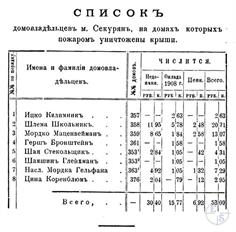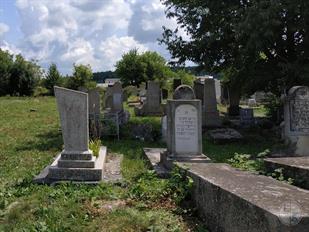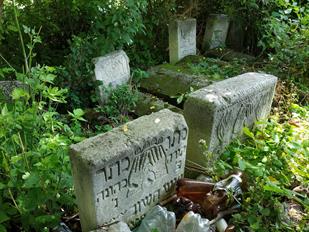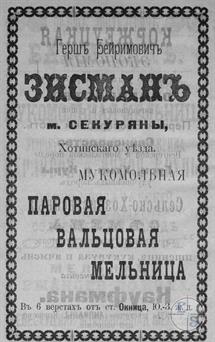Sokyryany
Dnister district, Chernivtsi region
An organized community in Sokyryany didn't exist, in fact, until the Revolution of 1918 and public affairs executed by a group of community “notables” from among those who frequented the governor's “court”. At their head were Yehiel Moses, Ya'acov Shlomo Shaykes, Shmuel Zalman's, Haim Hirsch Kotlyers, Yossel Sussman, Avraham Franck, Manasseh Karnos, Shabtai Senders, Zalmina Wexler, Yankel Kalmans, Froike Tchiglik, Mordecai Alkanowitz, and others.
Their field of operations was representation before the governor, road repairs, cemetery management, cleaning of, and general care for, the wells, confirmation of candidates for the village council and its offices, the preparation of tax lists and rentals. It was from this that the salaries of the religious officials were paid: Rabbis, ritual slaughterers, cantors, etc.
The group, however, never succeeded in electing a Jewish community-head (Starosta) who, in Tsarist Russia, is ipso facto the official representative of the community before the authorities. Only after many years, with the appointment of Yehiel Moses as the government-appointed Rabbi did matters at last become organized with the election of Shlomo Grossman as head of the community.
National schools did not exist until 1898. Nevertheless by chance, a Yeshiva graduate H. Ratner, from Lithuania arrived in Sokyryany and with the assistance of Alex Feldberg and a group of educated leaders from the community managed to obtain a license from the authorities to open a national Jewish school.
The school did not continue for long: the manager was newly-married and became a trader in produce while his friend Alex Feldberg moved to America. When he returned from there he joined the teacher Shapira and together they reopened a national school in Moshe Kabaks house. That school, too, closed after about two years as a result of the local teachers reporting the school to the authorities because it deprived them of their livelihood. But again stubbornly, Shapira this time opened a “Heder M'tukan”.
In 1905 a “Heder” was opened by the respected Berman and Zeidler and in 1908 a school was opened by Goldstein.
Their field of operations was representation before the governor, road repairs, cemetery management, cleaning of, and general care for, the wells, confirmation of candidates for the village council and its offices, the preparation of tax lists and rentals. It was from this that the salaries of the religious officials were paid: Rabbis, ritual slaughterers, cantors, etc.
The group, however, never succeeded in electing a Jewish community-head (Starosta) who, in Tsarist Russia, is ipso facto the official representative of the community before the authorities. Only after many years, with the appointment of Yehiel Moses as the government-appointed Rabbi did matters at last become organized with the election of Shlomo Grossman as head of the community.
National schools did not exist until 1898. Nevertheless by chance, a Yeshiva graduate H. Ratner, from Lithuania arrived in Sokyryany and with the assistance of Alex Feldberg and a group of educated leaders from the community managed to obtain a license from the authorities to open a national Jewish school.
The school did not continue for long: the manager was newly-married and became a trader in produce while his friend Alex Feldberg moved to America. When he returned from there he joined the teacher Shapira and together they reopened a national school in Moshe Kabaks house. That school, too, closed after about two years as a result of the local teachers reporting the school to the authorities because it deprived them of their livelihood. But again stubbornly, Shapira this time opened a “Heder M'tukan”.
In 1905 a “Heder” was opened by the respected Berman and Zeidler and in 1908 a school was opened by Goldstein.
Sources:
- Jewish encyclopedia of Brockhaus & Efron. St. Petersburg, 1908-1913
- The address-calendar of the Bessarabia province for 1912. Ed. B.A.Tapiro. Printing house of the Bessarabian provincial rule, Chisinau, 1911
- Dr. Yona Bieder. Milestones in the History of Sokyryany / Sekiryani, Bessarabia - alive and destroyed. Ed. Ze'ev Igeret, Committee of Former Residents of Sekiryani, Tel Aviv 1964. Translated by Selwyn Rose, JewishGen, Inc
- Bessarabian region. List of populated places according to 1859. St. Petersburg, 1861
- I.A. Altman (ed.), Holokost na tieritorii SSSR, Moscow 2009
Photo:
- European Jewish Cemeteries Initiative. Sokyryany Jewish Cemetery
- Jewish encyclopedia of Brockhaus & Efron. St. Petersburg, 1908-1913
- The address-calendar of the Bessarabia province for 1912. Ed. B.A.Tapiro. Printing house of the Bessarabian provincial rule, Chisinau, 1911
- Dr. Yona Bieder. Milestones in the History of Sokyryany / Sekiryani, Bessarabia - alive and destroyed. Ed. Ze'ev Igeret, Committee of Former Residents of Sekiryani, Tel Aviv 1964. Translated by Selwyn Rose, JewishGen, Inc
- Bessarabian region. List of populated places according to 1859. St. Petersburg, 1861
- I.A. Altman (ed.), Holokost na tieritorii SSSR, Moscow 2009
Photo:
- European Jewish Cemeteries Initiative. Sokyryany Jewish Cemetery
Sokyryany (Ukr. Sokyryany), city (since 1960), until 2020 district center in Chernivtsi region. Known since 1604. In 17-18 centuries - the township in the historical Bessarabia region of the Principality of Moldova. Since 1812 in Khotyn district of Bessarabia province of Russian Empire, in 1918 - 1940 as part of the Kingdom of Romania, in 1940 - 91 - as part of the Ukrainian SSR.
In 1897, 5042 Jews lived in Sokyryany (56%),
in 1930 - 4216 Jews.
In 1859, ther were 4 Jewish prayer houses.
Until 1890 Sokyryany didn't have an officially appointed rabbi of its own and the registry of births and deaths was recorded by the secretariat of the rabbi of Briceni, Mr. Bushewsky. Then, one day, Mr. Yehiel Moses was named official rabbi on the recommendation of the governor himself – General Lischin.
A bitter battle was fought for many years between the various contenders and their respective supporters: Dr. Bronstein and at his side Dr. Kauffman and his supporter Dr. Sussman. But nothing helped – Yehiel Moses remained the officially appointed and securely “enthroned” rabbi until his death.
In 1897, 5042 Jews lived in Sokyryany (56%),
in 1930 - 4216 Jews.
In 1859, ther were 4 Jewish prayer houses.
Until 1890 Sokyryany didn't have an officially appointed rabbi of its own and the registry of births and deaths was recorded by the secretariat of the rabbi of Briceni, Mr. Bushewsky. Then, one day, Mr. Yehiel Moses was named official rabbi on the recommendation of the governor himself – General Lischin.
A bitter battle was fought for many years between the various contenders and their respective supporters: Dr. Bronstein and at his side Dr. Kauffman and his supporter Dr. Sussman. But nothing helped – Yehiel Moses remained the officially appointed and securely “enthroned” rabbi until his death.
 |
| The list of homeowners of the city of Sokyriany, on the houses of which the fire destroyed the roofs, 1908. All people on the list are Jews |
In 1940, several dozen Jews were sent to Siberia.
After the occupation by the Romanian troops, on October 9-10, 1941 98 Jews were killed (according to other sources - 150).
The remaining Jews were enclosed in camps in the villages of Vertuzhany and Yedintsy, and then deported to Transnistria, where the majority died.
On August 8, 1941, a transit camp for Jews from Bukovina and Bessarabia was organized in Sokyryany. On August 11, 20 852 people were in the camp.
On September 1, 1941, 10 201 Jews remained in the camp. On October 4, 700 people were killed. The murders continued in November 1941. Jews were shot 2 km over the city, on the way to Mogyliv-Podilsky. In 1945, the commission revealed 1.7 thousand corpses.
In November 1941, the camp was liquidated, the Jews remained there were deported to Transnistria.
In total, of 30 thousand Jews deported to Transnistria, about 500 people survived.
After the occupation by the Romanian troops, on October 9-10, 1941 98 Jews were killed (according to other sources - 150).
The remaining Jews were enclosed in camps in the villages of Vertuzhany and Yedintsy, and then deported to Transnistria, where the majority died.
On August 8, 1941, a transit camp for Jews from Bukovina and Bessarabia was organized in Sokyryany. On August 11, 20 852 people were in the camp.
On September 1, 1941, 10 201 Jews remained in the camp. On October 4, 700 people were killed. The murders continued in November 1941. Jews were shot 2 km over the city, on the way to Mogyliv-Podilsky. In 1945, the commission revealed 1.7 thousand corpses.
In November 1941, the camp was liquidated, the Jews remained there were deported to Transnistria.
In total, of 30 thousand Jews deported to Transnistria, about 500 people survived.

- Home
- Shtetls
- Vinnytsia region
- Volyn region
- Dnipro region
- Donetsk region
- Zhytomyr region
- Zakarpattia region
- Zaporizhzhia region
- Ivano-Frankivsk region
- Kyiv region
- Kropyvnytskyi region
- Luhansk region
- Lviv region
- Mykolayiv region
- Odessa region
- Poltava region
- Rivne region
- Sumy region
- Ternopil region
- Kharkiv region
- Kherson region
- Khmelnytskyi region
- Chernihiv region
- Chernivtsi region
- Cherkasy region
- Crimea
- Synagogues
- Cemeteries
- Objects & guides
- Old photos
- History
- Contact
Jewish towns of Ukraine
My shtetl
My shtetl
Donate
Jewish towns of Ukraine


